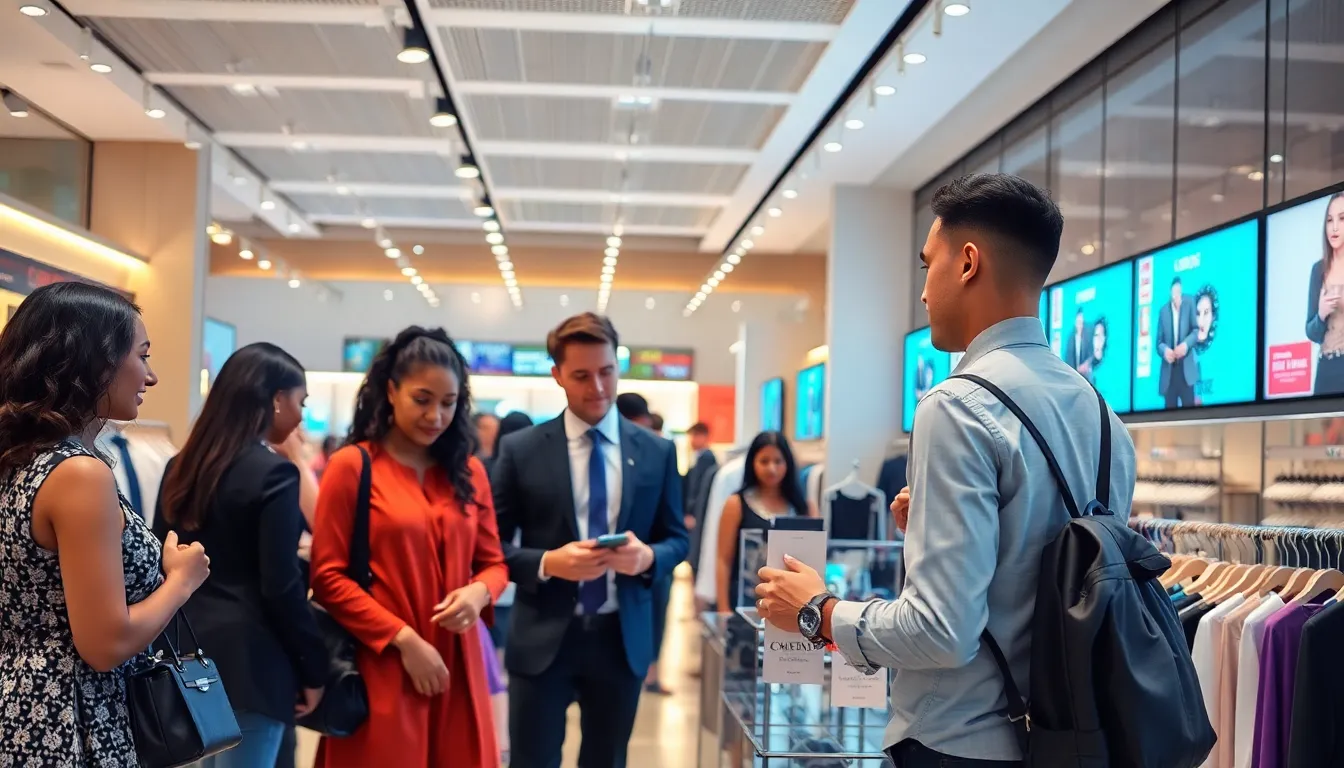The retail sector is in a constant state of evolution, shaped by shifting consumer preferences and technological advancements. As shoppers increasingly turn to online platforms, traditional brick-and-mortar stores must adapt or risk obsolescence. Today’s retail landscape demands agility and innovation, making it essential for businesses to stay ahead of emerging trends.
From the rise of omnichannel strategies to the growing importance of sustainability, retailers face both challenges and opportunities. Understanding these trends not only helps businesses thrive but also enhances the overall shopping experience for consumers. As the retail world transforms, staying informed about these developments is crucial for anyone looking to navigate this dynamic environment successfully.
Table of Contents
ToggleOverview of Retail Sector Trends
The retail sector experiences significant changes driven by consumer behavior and technology. Emerging trends reshape how retailers operate and interact with customers.
Omnichannel Retailing
Omnichannel retailing integrates multiple shopping channels for a seamless experience. Retailers leverage online platforms, mobile apps, and in-store experiences, allowing customers to switch between channels effortlessly. Examples such as buy online, pick up in-store (BOPIS) highlight this effective strategy.
E-commerce Growth
E-commerce continues to expand, with sales expected to make up 22% of global retail by 2024. Brands invest in robust online platforms to meet customer demand. Offering personalized recommendations enhances user experience and drives sales.
Sustainability Efforts
Sustainability remains a core focus for retailers. Many companies implement eco-friendly practices, such as using renewable materials and reducing waste. According to a Nielsen report, 73% of global consumers prefer brands committed to sustainability.
Technological Advancements
Retailers adopt advanced technologies to improve operations. Artificial intelligence (AI) and machine learning optimize inventory management and enhance customer engagement. In-store technologies, like augmented reality (AR), provide interactive experiences that attract customers.
Personalization Strategies
Personalization becomes essential as consumers expect tailored shopping experiences. Retailers utilize customer data to create targeted marketing campaigns and customized recommendations. This approach increases customer loyalty and satisfaction.
Subscription Services
Subscription services gain popularity in the retail sector, offering convenience and profitability. Brands like Dollar Shave Club and Birchbox exemplify this trend, providing curated products and services on a recurring basis.
Social Commerce
Social media platforms evolve into shopping channels, enabling retailers to sell directly through platforms like Instagram and Facebook. This trend enhances brand visibility and connects with younger consumers, who spend significant time on these platforms.
Staying attuned to these trends allows retailers to innovate and adapt strategies effectively, ensuring resilience in the ever-changing retail landscape.
E-commerce Growth

E-commerce growth continues to redefine the retail landscape, compelling businesses to adapt quickly to meet consumer demands. With technology at its core, the online shopping experience evolves rapidly.
Impact of Technology
Technology drives e-commerce growth, enhancing operational efficiencies and customer interactions. Online retailers integrate advanced analytics, AI, and machine learning for personalized shopping experiences. Major platforms utilize chatbots for 24/7 customer service, optimizing engagement and response times. Augmented reality (AR) features enable customers to visualize products in their actual environments, improving decision-making. Payment processing advancements, including digital wallets and buy-now-pay-later options, streamline transactions, increasing conversion rates significantly.
Changing Consumer Behavior
Shifts in consumer behavior influence e-commerce dynamics. Consumers increasingly prefer the convenience of online shopping, with 42% of global shoppers stating that they purchase products online at least once a month. Mobile commerce continues to rise, with over 50% of e-commerce transactions occurring on smartphones. Social media also plays a pivotal role, as 73% of millennials prefer to shop using social media platforms, driving brands to optimize their social commerce strategies. Brands adapting to these behaviors often experience higher customer loyalty, as personalized recommendations greatly enhance the shopping experience.
Sustainability in Retail
Sustainability has emerged as a central theme in the retail sector, driven by heightened awareness of environmental issues among consumers and the industry’s desire to reduce its ecological footprint.
Eco-friendly Practices
Retailers are increasingly adopting eco-friendly practices to minimize their environmental impact. Many businesses are implementing sustainable sourcing strategies, choosing materials that are renewable, recyclable, or biodegradable. For example, companies like H&M and Patagonia prioritize organic cotton and recycled polyester in their product lines. Additionally, brands are optimizing logistics and packaging. Using reusable or compostable packaging reduces waste. According to a 2023 report from McKinsey, 27% of global consumers prefer brands with sustainable practices. Investing in energy-efficient technologies also contributes to reduced carbon emissions in retail operations.
Consumer Demand for Sustainability
Consumer demand for sustainability influences purchasing decisions significantly. Surveys indicate that approximately 70% of consumers are willing to pay a premium for sustainable products. As carbon footprints become a focal point for brands, transparency in sourcing and production practices garners consumer trust. Businesses that successfully communicate their sustainable efforts often see an increase in customer loyalty. Furthermore, millennials and Gen Z shoppers prioritize sustainability, driving brands to innovate consistently in environmental practices. Retailers that align with these values can enhance their market position and foster stronger connections with their customer base.
Personalization and Customer Experience
Personalization significantly enhances customer experience in the retail sector. Retailers leverage data to tailor shopping experiences, fostering customer loyalty and satisfaction.
Importance of Data Analytics
Data analytics plays a crucial role in understanding consumer behaviors and preferences. Retailers collect data from multiple sources, including online transactions, customer feedback, and social media interactions. Analyzing this data reveals insights on shopping habits, enabling targeted marketing strategies. For instance, 57% of consumers value personalized offers based on their previous purchases. Retailers using predictive analytics can anticipate trends and adjust inventory levels accordingly, ensuring they meet customer demand effectively. This data-driven approach not only increases sales but also strengthens customer engagement.
Customized Shopping Experiences
Customized shopping experiences create a unique interaction between the consumer and the retailer. Retailers employ artificial intelligence to provide personalized product recommendations based on individual preferences and shopping history. For example, online platforms like Amazon and Netflix utilize algorithms to suggest products and content that cater to specific interests. In-store technologies, such as interactive displays and mobile apps, further enhance this experience by guiding customers through personalized promotions and offerings. Companies that prioritize customization often report higher conversion rates and increased customer retention, demonstrating the effectiveness of tailored strategies in today’s competitive retail market.
Omnichannel Strategies
Omnichannel strategies have become essential for retailers seeking a comprehensive approach to satisfy diverse consumer preferences. These strategies create a seamless shopping experience across both online and offline platforms, enhancing customer engagement and loyalty.
Integration of Online and Offline Channels
Integration of online and offline channels plays a crucial role in omnichannel retailing. Retailers combine digital platforms with physical stores to ensure consistency in branding and customer experience. Various tactics include:
- Unified Messaging: Providing consistent branding messages across websites, social media, and in-store promotions reinforces brand identity.
- Click-and-Collect Services: Allowing customers to order online and pick up in-store creates convenience and drives foot traffic.
- Cross-Channel Returns: Enabling returns for online purchases in physical locations simplifies the process and improves customer satisfaction.
- Inventory Transparency: Sharing real-time inventory data across channels helps manage stock levels and reduce out-of-stock situations.
Retailers that effectively integrate online and offline channels benefit from enhanced customer loyalty and improved sales performance.
Role of Social Media
The role of social media in omnichannel strategies cannot be overstated. Social media platforms serve as vital touchpoints for customer interaction and brand engagement. Key aspects include:
- Social Commerce: Utilizing social media for direct sales enables brands to reach customers where they spend significant time. Platforms like Instagram and Facebook support shopping features that streamline the purchasing process.
- Targeted Advertising: Leveraging consumer data from social platforms allows retailers to create highly targeted advertisements that resonate with specific demographics.
- Engagement and Feedback: Engaging with customers through comments, messages, and reviews builds community and trust while providing valuable feedback that can inform product development and marketing strategies.
- Content Marketing: Sharing engaging content, such as tutorials and behind-the-scenes looks, fosters a deeper connection and encourages repeat visits to both online and physical stores.
By harnessing the power of social media, retailers strengthen their omnichannel strategies, creating a cohesive experience that aligns with modern consumer behavior.
The retail sector is at a pivotal moment where adaptation is crucial for success. Embracing trends like omnichannel strategies and sustainability not only meets consumer demands but also positions brands for long-term growth. As technology continues to evolve the shopping experience personalization and data analytics will play a significant role in fostering customer loyalty. Retailers that remain agile and responsive to these changes can thrive in a competitive landscape. Staying informed and proactive will be key to navigating the complexities of modern retail, ensuring that businesses not only survive but flourish in the face of ongoing transformation.








